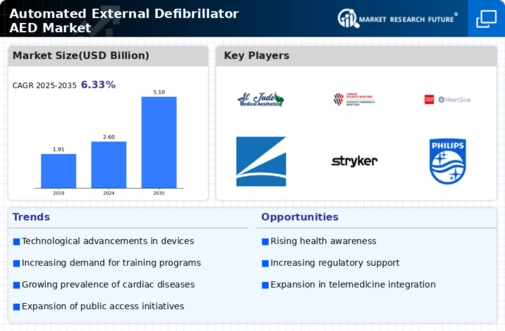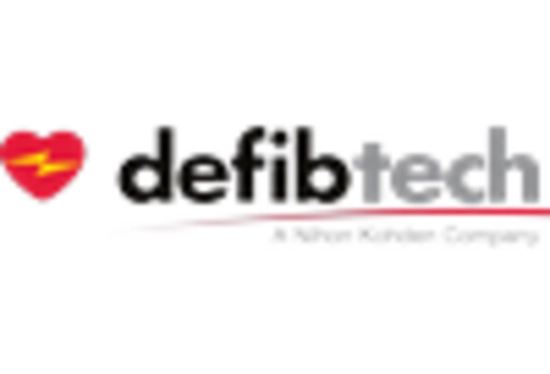Technological Innovations in AEDs
Technological innovations are significantly shaping the Automated External Defibrillator Market AED Market. Recent advancements have led to the development of more compact, lightweight, and user-friendly AEDs, which are easier to deploy in emergency situations. Features such as voice prompts, visual aids, and real-time feedback during CPR are enhancing the usability of these devices. Moreover, the integration of connectivity features allows for remote monitoring and data collection, which can be invaluable for maintenance and training purposes. As manufacturers continue to innovate and improve the functionality of AEDs, the market is expected to expand. The ongoing evolution of technology in the Automated External Defibrillator Market AED Market suggests a promising future for both manufacturers and end-users.
Rising Incidence of Cardiac Arrest
The increasing prevalence of cardiac arrest cases is a primary driver for the Automated External Defibrillator Market AED Market. Statistics indicate that approximately 350,000 cardiac arrests occur annually in the United States alone, with a significant portion happening outside of hospitals. This alarming trend underscores the necessity for accessible defibrillation devices in public spaces, workplaces, and homes. As awareness of the importance of immediate response to cardiac emergencies grows, the demand for AEDs is likely to rise. Furthermore, the survival rate for cardiac arrest victims significantly improves with prompt defibrillation, which further propels the market. The urgency to equip communities with these life-saving devices is becoming more pronounced, suggesting a robust growth trajectory for the Automated External Defibrillator Market AED Market.
Integration of AEDs in Public Spaces
The integration of Automated External Defibrillators AEDs in public spaces is becoming increasingly prevalent, serving as a crucial driver for the Automated External Defibrillator Market AED Market. Many municipalities and organizations are recognizing the importance of having AEDs readily available in high-traffic areas such as airports, shopping malls, and sports venues. This trend is supported by legislation in various regions mandating the presence of AEDs in public facilities. As a result, the market is witnessing a surge in demand for AEDs that are user-friendly and easily accessible. The presence of these devices not only enhances public safety but also fosters a culture of preparedness, which is likely to contribute to the sustained growth of the Automated External Defibrillator Market AED Market.
Growing Awareness of Sudden Cardiac Arrest
The growing awareness of sudden cardiac arrest and its implications is a critical driver for the Automated External Defibrillator Market AED Market. Educational campaigns and training programs are increasingly emphasizing the importance of recognizing cardiac arrest symptoms and the need for immediate defibrillation. This heightened awareness is leading to a greater acceptance of AEDs in workplaces, schools, and community centers. As more individuals become trained in CPR and AED usage, the likelihood of these devices being utilized effectively in emergencies increases. Consequently, the demand for AEDs is expected to rise, as organizations seek to equip their facilities with these essential tools. The ongoing efforts to educate the public about sudden cardiac arrest are likely to have a lasting impact on the Automated External Defibrillator Market AED Market.
Increased Investment in Healthcare Infrastructure
The growing investment in healthcare infrastructure is a notable driver for the Automated External Defibrillator Market AED Market. Governments and private entities are allocating substantial resources to enhance emergency medical services and public health initiatives. This investment often includes the procurement of AEDs for hospitals, clinics, and community health programs. As healthcare systems evolve to prioritize rapid response to cardiac emergencies, the demand for AEDs is likely to increase. Furthermore, partnerships between healthcare providers and AED manufacturers are becoming more common, facilitating the distribution of these devices in various settings. This trend indicates a positive outlook for the Automated External Defibrillator Market AED Market, as enhanced healthcare infrastructure directly correlates with the need for life-saving equipment.


















Leave a Comment